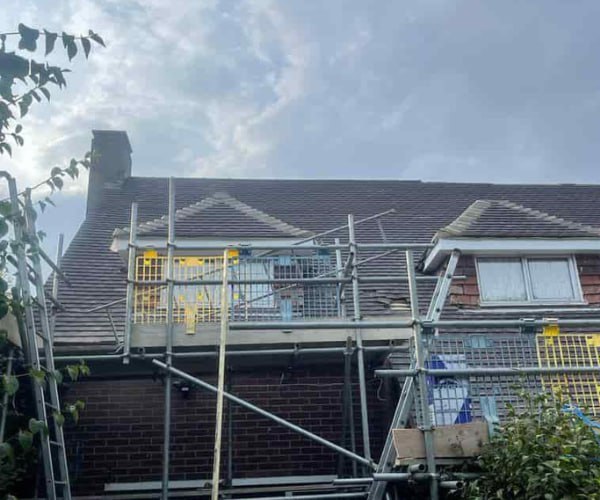10 Essential Maintenance Tips for Pitched Roofs
Introduction
Pitched roofs are a defining feature of many homes across the UK, offering effective drainage and timeless aesthetic appeal. However, to preserve their performance and appearance, they require regular inspection and care. Neglecting routine maintenance can lead to costly repairs or premature failure, especially in areas like Sandy, Bedfordshire where weather conditions can vary throughout the year.
At FP Roofing Sandy, we specialise in maintaining and repairing pitched roofs with precision and professionalism. In this guide, we share ten essential maintenance tips every property owner should follow to keep their pitched roof in top condition.
1. Inspect the Roof Twice a Year
Routine visual inspections are the cornerstone of roof maintenance. Check your pitched roof at least twice a year—ideally in spring and autumn—and after major storms.
Look for:
- Loose, missing, or cracked tiles
- Moss and algae growth
- Sagging or uneven sections
- Signs of water ingress in loft spaces
Spotting issues early can prevent minor problems from escalating.
2. Clean Gutters and Downpipes
Clogged gutters can cause water to back up under tiles, damaging roof timbers and ceilings.
Make sure to:
- Remove leaves, moss, and debris
- Flush gutters and downpipes with water
- Check for rust, corrosion, or misalignment
Regular cleaning is particularly important in autumn when leaf fall is at its peak.
3. Trim Overhanging Branches
Trees that grow too close to your roof can drop leaves and branches, damage tiles, and invite pests.
Maintain clearance by:
- Trimming back branches that overhang or touch the roof
- Removing any deadwood that could fall during storms
- Monitoring tree growth throughout the year
This also helps to reduce moss and lichen by allowing more sunlight to reach the roof surface.
4. Check for Moss and Algae Growth
Moss retains moisture and can lift tiles or block water channels, while algae can cause discolouration.
Remove growth using:
- A stiff-bristle brush and mild moss remover
- Specialist roof cleaning products that prevent regrowth
- Professional soft-washing techniques for delicate surfaces
Avoid pressure washing, as it can damage tile coatings and dislodge materials.
5. Monitor Roof Flashings
Flashings protect the joints around chimneys, skylights, and valleys. Damaged or loose flashings are a common cause of leaks.
Inspect for:
- Cracks, lifting edges, or corrosion
- Poor sealing or deteriorated mortar
- Discolouration or signs of moisture beneath
At FP Roofing Sandy, we offer comprehensive flashing repair and replacement services across Sandy, Bedfordshire.
6. Look Inside Your Loft
Not all roof issues are visible from the outside. Your loft or attic space can provide vital clues about roof health.
Inside checks should include:
- Signs of water stains or damp patches
- Mould or mildew growth
- Gaps in insulation or daylight showing through tiles
Timely detection helps prevent structural timber damage and energy loss.
7. Replace Damaged Tiles Promptly
Cracked, slipped, or broken tiles can allow water to seep beneath the roofing layers.
A professional should:
- Match and install new tiles securely
- Assess surrounding tiles for further issues
- Check underlay and battens for water damage
Regular tile checks are especially important after windstorms or heavy rain.
8. Ensure Proper Ventilation
Poor ventilation can lead to condensation in the roof space, encouraging rot and mould.
Ensure your roof has:
- Adequate eaves and ridge ventilation
- Vents that are free from blockages
- No signs of stagnant air or odours in the loft
Proper airflow helps regulate moisture and prolong the life of your roof structure.
9. Check Ridge and Hip Tiles
These tiles protect the topmost seams of your pitched roof. If dislodged, they can expose the roof to rain and wind damage.
Check for:
- Cracks in mortar
- Displaced or missing tiles
- Loose bedding or pointing
Our team at FP Roofing Sandy can re-bed or repoint ridge and hip tiles to maintain weather resistance.
10. Schedule a Professional Roof Survey
While DIY inspections are useful, a qualified roofer can spot deeper or hidden problems and offer long-term solutions.
A professional roof survey will include:
- Full tile and flashing check
- Underlay and insulation assessment
- Drainage and structural analysis
- A detailed condition report with recommendations
Regular surveys, ideally every 3 to 5 years, provide peace of mind and help plan for future maintenance.
Conclusion
Maintaining a pitched roof doesn’t need to be complicated, but it does require consistency and expert oversight. By following these ten essential tips, homeowners in Sandy, Bedfordshire can protect their properties from weather damage, improve energy efficiency, and extend the life of their roofing system.
At FP Roofing Sandy, we offer a full range of pitched roof maintenance and repair services designed to keep your roof performing at its best. If you need professional assistance or a comprehensive inspection, get in touch with our experienced team today. We’re here to help safeguard your home with reliable, high-quality roofing solutions.
Call us on: 01767 667 088
Click here to find out more about FP Roofing Sandy
Click here to complete our contact form and see how we can help with your roofing needs.

